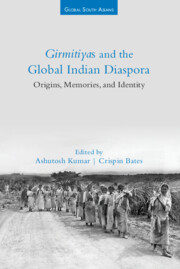4 - Traces of Female Bhojpuri Migrants in Suriname
Published online by Cambridge University Press: 20 April 2024
Summary
This chapter explores the portrayal of Bhojpuri indentured female migrants and their identity formation in Surinamese photographs. By examining several archival photographs, I connect visual traces to various contemporaneous cultural developments described by Tejaswini Niranjana, Roshini Kempadoo, Marina Carter, Anouk de Kooning and Patricia Mohammed. Analysing the photographs, considering the social circumstances that must have influenced identity formation, it is possible to reconstruct the social roles that were imposed on women migrants. As noted by Bhikhu Parekh, I attempt to understand the journey of these women and how they were transformed by diasporic experiences. Since Bhojpuri females belonged to villages characterized by diverse Indian traditions, how did the latter remain or change within this process leading to multiple identities? These photographs can be mined not just for their archival and historical value but also for what they aesthetically communicate and the way they have been staged. The photographs have been archived in various collections, including the National Archives, the Tropenmuseum and the Rijksmuseum collection in the Netherlands.
There is a lack of academic scholarship on female indentured labourers in archival photographs. The images selected from Suriname feature individuals from Chinese, Indian and Indonesian indentured labour communities that were shipped there and lived alongside the descendants of enslaved Africans. Women have been documented in the actual landscape of the places they lived in Suriname, becoming agents of reinvention and cultural innovation. This chapter seeks to address and discuss this, in particular the ethnic mixture and diverse cultural influences that are visually unavoidable in these images. I argue that by viewing the cultural and ethnic diversity apparent in these photos, we can analyse visual traces that may indicate the emancipation of female Bhojpuri migrants from gender norms based in the rural settings in India.
THE ARRIVAL OF BHOJPURI MIGRANTS
After the abolition of slavery by the Dutch government in 1863, indentured labourers were required in Suriname to maintain the plantation economy. Most of the recruited labourers came from the region covering the western part of Bihar and eastern Uttar Pradesh (UP). The present generation of diasporic Indians living in Suriname and the Netherlands have their migrant roots mostly in these Bhojpuri- and Awadhi-speaking regions.
When the first ships with Indian indentured migrants from Calcutta arrived in Suriname in 1873, only a small proportion of the inhabitants were Dutch.
- Type
- Chapter
- Information
- Girmitiyas and the Global Indian DiasporaOrigins, Memories, and Identity, pp. 83 - 118Publisher: Cambridge University PressPrint publication year: 2024



